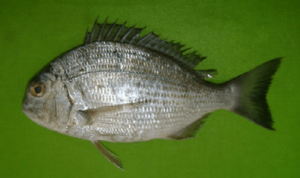Karanteen seabream facts for kids
Quick facts for kids Karanteen seabream |
|
|---|---|
 |
|
| Conservation status | |
| Scientific classification | |
| Synonyms | |
|
Sparus crenidens Forsskål, 1775 |
The Crenidens crenidens, also known as the karanteen seabream or just karanteen, is a type of fish. It belongs to the Sparidae family, which includes many kinds of seabream. A Swedish scientist named Peter Forsskål first described this fish in 1775.
This fish naturally lives in the western Indian Ocean. However, since 1970, it has also started living in the eastern Mediterranean Sea. The karanteen seabream is one of only three species in its group, called the genus Crenidens.
Contents
About the Karanteen Seabream
The karanteen seabream was first officially named Sparus crenidens in 1775 by Peter Forsskål. He was a Swedish-speaking Finnish explorer and naturalist. He found this fish in the Red Sea near Jeddah in Saudi Arabia and in the Gulf of Suez in Egypt.
Later, in 1830, another scientist named Achille Valenciennes created a new group, or genus, called Crenidens just for this fish. So, the karanteen seabream is the main example of the Crenidens group. This group of fish is part of the larger Sparidae family.
For a long time, scientists thought there were two types, or subspecies, of karanteen seabream:
- C. c. crenidens: Found in the Red Sea and along the eastern African coast.
- C. c. indicus: Found from the Red Sea all the way to the Persian Gulf.
However, recent studies show that these two types are actually separate species. There might even be a third species called Crenidens macracanthus.
What Does It Look Like?
The karanteen seabream has a body shaped like an oval, and it's a bit flattened from side to side. Smaller adult fish, those less than 19.7 centimeters (about 7.7 inches) long, have a small bump on their nose, right in front of their eye.
Their mouth reaches back to their front nostril. They have three rows of teeth in each jaw. The front teeth in the upper jaw are like incisors, with 8 or 9 brown-tipped teeth. Each of these teeth has five small bumps, which makes the edge look wavy. The other teeth are more granular, like tiny grains.
The fish's scales are finely ctenoid, meaning they have tiny comb-like edges. Their cheeks are scaly, but the area between their eyes is smooth and doesn't have scales.
The fin on its back, called the dorsal fin, has eleven spiny rays and eleven soft rays. The fin on its underside, the anal fin, has three spiny rays and ten soft rays. Its tail fin is forked, like a "V" shape. It also has 52 to 60 scales along its lateral line, which is a special line of sensory scales along its side.
The karanteen seabream is usually silvery greenish-blue or olive in color. It has darker, thin stripes along its body, made by dark spots on its scales. Its fins are dull yellowish or olive. The dorsal fin often has a dark edge.
These fish can grow up to 30 centimeters (about 12 inches) long in their native homes. However, in the Mediterranean Sea, they usually only reach about 20 centimeters (about 8 inches). Most often, they are between 10 and 16 centimeters (4 to 6 inches) long.
Where Do They Live?
The karanteen seabream originally comes from the western Indian Ocean. You can find them from the Red Sea down the coast of eastern Africa, all the way to South Africa. They have also been seen near southern Madagascar.
In 1970, this fish was seen for the first time in the Mediterranean Sea, in the Bardawil Lagoon in northern Egypt. Since then, it has spread to Israel and Libya. Scientists believe the most likely way this fish got into the Mediterranean Sea was by swimming through the Suez Canal.
Life and Habits
Karanteen seabream live in shallow coastal waters. They prefer areas with sandy bottoms, especially those covered with sea grass.
Their main food source is algae, which are like tiny water plants. But they also eat small invertebrates, such as crustaceans (like tiny crabs or shrimp) and worms.
The eggs and young larvae of the karanteen seabream float in the water as plankton. Off the coast of Libya, these fish have a clear breeding season from November to February. In March and April, the fish move away from the coast to lay their eggs elsewhere.
Male karanteen seabream become old enough to reproduce when they are about 14 centimeters (5.5 inches) long. Some females can reproduce when they are around 13 to 13.9 centimeters (5.1 to 5.5 inches) long. However, half of the females are ready to reproduce when they reach about 15.4 centimeters (6 inches) in length. The number of eggs a female lays depends on her weight, ranging from 678 eggs in smaller females to 9,888 eggs in larger ones.
How People Use Them
In the northern Indian Ocean, karanteen seabream are caught all year round. Fishermen use trammel nets and beach seines to catch them. People usually eat them fresh.
However, in the southern part of the Indian Ocean, these fish are mostly caught and used as bait for other types of fishing.


